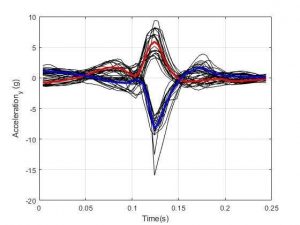Jake Popperwell
Use of inertial sensors and their placement on the body to detect boxing performance
The funds provided to me by the ISEA helped me with travel and accommodation costs whilst living in Australia. This enabled me to fully focus my time on the role as a Sports Engineering research intern at Griffith University. I focused my research on looking into the use of inertial sensors to detect boxing performance. By the end of the internship we had completed an extensive research project that has the potential to be published into the Journal of Sports Engineering.
The paper reported a quantitative assessment of sensor placement to detect magnitudes in boxing using IMU data. Our hypothesis stated the 3rd thoracic vertebrae sensor would be able to:
- Be used instead of wrist sensors to detect acceleration, gyration and magnetometer outputs of punches.
- Distinguish between a left and a right punch using sensor data.
- Detect fatigue in an athlete.
- Identify when a punch lands and its attenuation throughout the body.
The funds provided to me by the ISEA helped me with travel and accommodation costs whilst living in Australia. This enabled me to fully focus my time on the role as a Sports Engineering research intern at Griffith University. I focused my research on looking into the use of inertial sensors to detect boxing performance. By the end of the internship we had completed an extensive research project that has the potential to be published into the Journal of Sports Engineering.
The paper reported a quantitative assessment of sensor placement to detect magnitudes in boxing using IMU data. Our hypothesis stated the 3rd thoracic vertebrae sensor would be able to:
- Be used instead of wrist sensors to detect acceleration, gyration and magnetometer outputs of punches.
- Distinguish between a left and a right punch using sensor data.
- Detect fatigue in an athlete.
- Identify when a punch lands and its attenuation throughout the body.
It was determined that an IMU sensor placed at T3 is suitable to monitor boxing performance in some scenarios. It is possible to determine both left and right punches along with their magnitudes when observing punch profiles and taking into consideration their time delay. Overall the use of a sensor located at the T3 is more favourable than located at the wrist due to being less invasive, smaller acceleration peaks and reduced chance of being damaged during testing. When testing fatigue the results were inconclusive with the peak acceleration increasing over the seven sets where it was hypothesised to decrease. Both the pad work and sparring trials were again able to identify left and right hand punches with a varying degree of accuracy however there was evidence that the sensors do have the capacity to be used in a dynamic environment.
Further research is needed in order to determine whether the T3 is as optimal as the wrist for detecting fatigue and whether the increased acceleration is being caused by an over acceleration at the shoulders. A more in depth analysis of each type of punch would allow a clearer understanding of if (and how) individual punch characteristics differ from one another in their punch profiles. Finally, research into the development of a machine learning model would provide a better understanding in how possible it is to use an automatic points scoring system in a competitive scenario.
As an undergraduate student I will be returning to Leeds to finish my BSc degree in Sport and Exercise Science (Industrial). However colleagues at Griffith University will continue the work with these sesnors to further analyse boxing performance.
